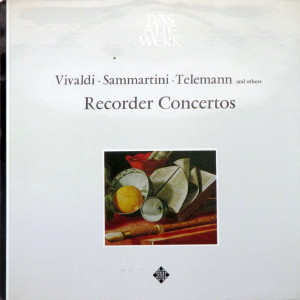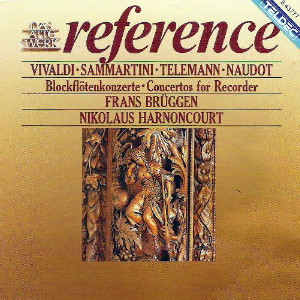 |
1 LP -
SAWT 9533-B - (p) 1968
|
 |
| 1 CD -
8.43777 ZS - (c) 1987 |
|
Recorder Concertos
|
|
|
|
|
|
|
|
| Antonio Vivaldi
(1675-1741) |
|
|
|
Concerto in C minor for
Recorder (in f'), strings and basso
continuo (F. VI/11)
|
|
10' 20" |
A1 |
- Allegro non molto
|
4' 44" |
|
|
| - Largo |
2' 05" |
|
|
| - (Presto) |
3' 49" |
|
|
|
|
|
|
| Giuseppe Sammartini
(1693-c.-1750) |
|
|
|
| Concerto in F major for
Recorder (in c" - "fifth flute"),
strings and basso continuo |
|
13' 20" |
A2 |
| - Allegro |
4' 29" |
|
|
- Siciliano
|
4' 59" |
|
|
- Allegro assai
|
4' 06" |
|
|
|
|
|
|
| Georg Philipp Telemann
(1681-1767) |
|
|
|
Concerto in C major for
Recorder (in f'), strings and basso
continuo
|
|
16' 00" |
B1 |
| - Allegretto |
3' 57"
|
|
|
| - Allegro |
3' 43" |
|
|
| - Andante |
4' 19" |
|
|
| - Tempo di Menuet |
4' 21" |
|
|
|
|
|
|
| Jean-Jacques Naudot (d.
1762?) |
|
|
|
| Concerto in G major for
Recorder (in f'), 2 violins and basso
continuo |
|
10' 11" |
B2 |
| - Allegro |
4' 37"
|
|
|
| - Adagio |
3' 00" |
|
|
| - Allegro |
2' 58" |
|
|
|
|
|
|
Frans Brüggen,
Blockflöte
|
|
|
|
CONCENTUS MUSICUS
WIEN (mit
Originalinstrumenten)
|
|
| Nikolaus
Harnoncourt und
Frans Brüggen, Leitung |
|
|
Luogo
e data di registrazione
|
| Casino Zögernitz,
Vienna (Austria) - 27 & 28 febbraio
1968 |
|
Registrazione
live / studio
|
| studio |
Producer
/ Engineer
|
Wolf
Erichson
|
Prima Edizione CD
|
Teldec
"reference" - 8.43777 ZS - (1 cd) - 49'
51" - (c) 1987 - AAD
|
Prima
Edizione LP
|
Telefunken "Das
Alte Werk" - SAWT 9533-B - (1 lp)
- 49'
51"
- (p) 1968
|
|
|
Notes
|
The period in which
the concertos on our disc originated
was no longer the heyday of recorder
playing and recorder music. While the
instrument witnessed a further late
flowering in chamber music shortly
after 1700, particularly in England,
France and Italy, in solo concertos it
produced only a rearguard action
oppressed both by the violin as the
new solo instrument of expression par
excellence and by the transverse
flute, whose tone was on the one hand
more brilliant and on the other
equally "soulful" - even though the
recorder continued to remain a
possibility as an alternative
instrument in works avaible for the
maximum variety of resources. That the
solo concerto bad originated shortly
before 1700 as a violin concerto and
above all had gained ground as a
violin concerto also contributed to
the recorder's inability to secure a
permanent footing - the more the
concerto developed and found favour as
the representative form of utterance
the more the shaping of the solo part
followed the technical and expressive
possibilities of the stringed
instrument. Thus the number of
surviving concertos which prescribe a
member of the recorder family as solo
instruments is extremely small, and
especially small in Italy, the
stronghold of the early violin
concerto, whereas in Paris and London,
as well as in Germany, the springs
flowed somewhat more strongly. The
selection on the present disc reflects
this proportion. At the same tima it
shows that a numerically sparse
tradition is not necerrarily
associated with any inferior quality
in the works handed down. In the hands
of an important the recorder, even in
the solo concerto of the early 18th
century, spoke with an attractive
voice unmistakably its own.
The resourcefulness in ideas and,
above all, the astonmishing tonal
imagination which never let Vivaldi's
concertos appear monotonus and
mechanical, for all the formal
similarity of most of his works, are
particularly impressively seen in the
recorder concerto in C minor (P. 440)
against a background of a still very
"baroque" style. In the sequence and
form of the movements, the
three-movement work conforms to
Vivaldi's normal solo concerto form;
but within these almost conventional
limits the composer's imagination can
expand all the more freely. It does so
particularly in the display of an
unusual virtuosity in the flute part
and in the enjoyment of colour in the
soli, which almost consistently are
accompained only by the upper strings
(without continuo) or, more seldom, by
the continuo alone, so that structural
contrast between tutti and soli is
underlined by the instrumentation, and
the soli take on a peculiarly clear,
almost sparkling, tonal character
which is till more intensified through
the consistently high register, the
virtuosic agility and the
characteristic tone of the recorder.
Instrumentation and tone colour as
elements of musical structure had been
far removed from high-baroque
concerto; Vivaldi has here become a
pioneer of a new style which was
eventually to find its fulfilment in
Mozart's orchestral writing. On the
other hand, in this concerto it is
precisely the "baroque" - for Vivaldi
seimply the conventional - elements
which cannot be overlooked, and the
bridging of these and the
forward-looking passages is not the
least charm of the work.
Between baroque and early classic, if
in a less pronunced style, also stands
the F major concerto of Giuseppe
Sammartini. The brother of the more
famous Giovanni Battista Sammartini
was one of the many Italian
instrumental composers of the 18th
century who sought their fortune north
of the Alps: after he had fist worked
as an oboist in Milan, he went in 1729
to London, where he became chamber
music director to the Prince of Wales,
and where he died around 1750 or 51.
In form his concerto, particurarly the
first movement, clearly reveals the
Vivaldi concerto type, though the
distinction between soli and tutti has
grown a little stronger than there: in
inflection and even in details of its
invention it is nevertheless a typical
"London" work from Handel and
Geminiani's circle. The first movement
shows this with its march-like
character, as does the finale, which
for all its vivacity and elegance is
no Italian dance movement lightly
thrown in but, in its relatively
compact and careful workmanship, still
preserves something of the dignity of
the great baroque concertos of
Corelli's successors. But the core of
the work is the middle movement, an
elegiac siciliano in the style of
Handel, which far surpasses the
elegant dignity of the outer
movements.
Telemann's C major flute concertos is
cast from a quite different mould: it
has been preserved for us from the
contents of the Darmstadt court
library and so perhaps belongs to the
composer's Frankfurt period. The
sequence of movements already reveals
that Telemann's model is not the
Italian solo concerto but rather the
late-baroque chamber sonata, and this
impression is confirmed by the
movement structure in which the strong
alternation of tutti and soli gives
way to the interplay of short
concertante and thematic passages, the
exceptional exhibitionist virtuosity
of the solo instrument to a thematic
dialoguebetween solo and orchestra.
The first movement, with its
rapturous, seemingly inexhaustible
flowing cantilena, its string of
sequences over long bass pedalpoints
and its dialogue of "nature" flute
motives and pizzicato-string idyllic
and bucolic moods, testifies that in
its thematic concentration and finish
it is entirely in the style of chamber
music, not of a concerto. The second
movement, Allegro, with its vital
syncopated rhythm, turns the sweet
pastoral mood of the first to a
rubuster rusticity. The grave A minor
Andante, structurally very similar to
the first movement and, like it, given
a chamber-music refinement, exploits
the attraction of constant major-minor
alternations. The finale, in the form
of a broad binary suite-movement,
stresses still more strongly the
virtuosity of the solo instrument and
reverts to the character of the second
movement, while at the same time
increasing its ehythmic vitality to a
genuine polonaise style.
Jean-Jacques Naudot's flute concerto
introduces a quite different sphere -
that of the art of aristocratic
Parisian society. Here the recorder
became a genre instrument which from
its tonal character had a folk-like,
bucolic aura which it shared woth the
vielle (which Naudot himeself played)
and the musette, and which was as much
enjoyed by Paris salon society, with
its nostalgic sentiments, as were
Boucher's bucolic idylls, which were
the fashion at this same time. Thus
Naudot's Op. 28 (after 1740), from
wich our concerto is drawn, was
intended "pour les vieles, musettes,
flûtes traversière, flûtes à bec, et
hatbois", which could as desired take
the upper part. while the other parts
were allotted to two violins and
continuo. The limitation thus imposed
on the upper part, particularly in
respect of performance technique,
accords with the style of the work: it
is the style not of the concerto but
of the consort, which could be played
just as well by solo chamber-music
performers as concerted, with several
strings to a part, and in which the
upper part hardly ever appeared alone
but mostly in concertante duet with
the first violin. The type and
character of the movements, again
conforms to this basis; they likewise
are completely French, and only seldem
show the influence of Italian
instrumental music. Thus the first
Allegro certainly bears Italian traces
in the gestures of its unison main
subject, but in the decorative
ornamentation, the dotted 3/4 rhythm
and the concertante duets of the flute
and violin entirely preserves the
French style and its specific
character, in which are combined
lightly ceremonious, courtly elegance
and lyrical simplicity. The solemn G
minor Adagio is completely attuned to
typically French rhythms, chains of
suspension and decorated sequences,
and only the finale, with its main
subject like a quotation from Vivaldi,
its cascades of semiquavers and its
stretches of chords, more clearly
alludes to the modern Italian spirit,
without indeed renouncing the basic
character of the Parisian
"divertissement".
Ludwig
Finscher
|
|
Nikolaus
Harnoncourt (1929-2016)
|

|

|
|